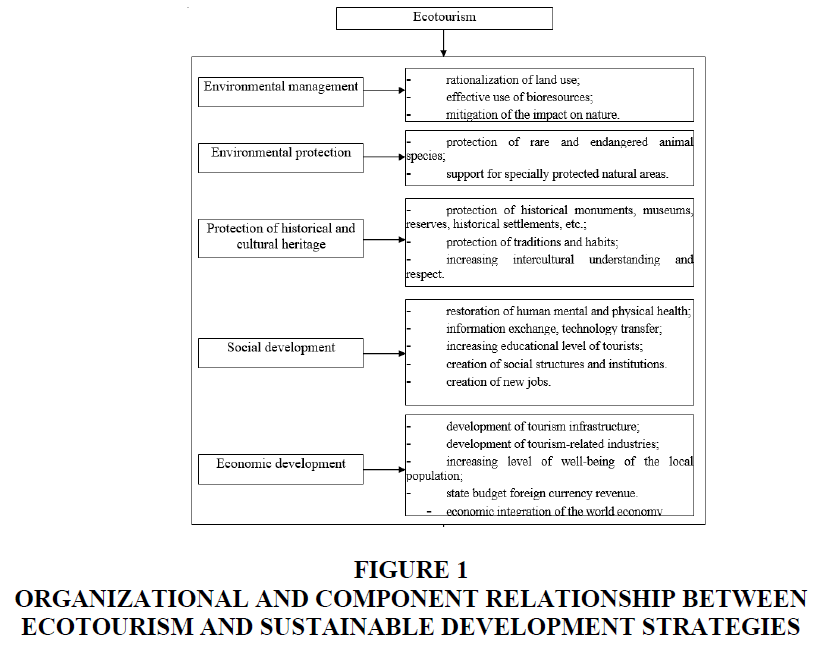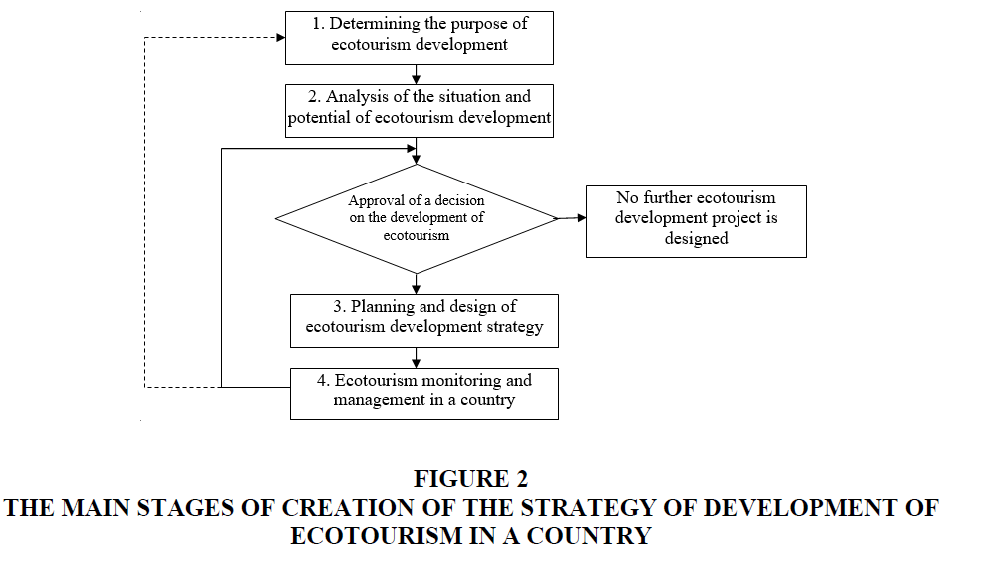Research Article: 2020 Vol: 24 Issue: 1S
Sustainable Development of Ecotourism in International Entrepreneurship Coordinates
Tetiana Humeniuk, National Aviation University, Ukraine
Oksana Perchuk, Pereiaslav-Khmelnytskyi State Pedagogical Grygorii Skovoroda University, Ukraine
Stanislav Petko, Kyiv National Economic University named after Vadym Hetman, Ukraine
Ganna Turchynova, Dragomanov National Pedagogical University, Ukraine
Nataliia Tytova, Dragomanov National Pedagogical University, Ukraine
Sergiy Babiy, Taras Shevchenko National University of Kyiv, Ukraine
Abstract
The article defines the conditions for sustainable development of ecotourism in the world economy in the sphere of international entrepreneurship. The classification of types and forms of ecotourism has been created in order to improve the choice of vectors for its development. The organizational algorithm of ecotourism development in international entrepreneurship coordinates is designed and the model of functional ecotourism support for the sustainable development of the tourism industry of the country is created.
Keywords
International Entrepreneurship, Strategic Analysis, Ecotourism, Sustainable Development, Environmental Management.
JEL Classifications
M5, Q2
Introduction
In the current world economy tourism is one of the fastest growing industries, and its burden on the environment and natural resources is increasing every year. Over the last two decades, international tourism has increased an average of 3.5-4% per year. The main driver of this growth is ecotourism, and an analysis of its current state shows the unique role of this type of tourism. Therefore, the problem of creating an effective system of strategic management and ensuring its sustainable development faces the participants of the ecotourism sector.
Methodology
The methodology of this study is based on a systematic approach to providing a strategy for the development of ecotourism; the method of comprehensive development of organizational and methodological recommendations on the creation of an effective system of strategic management; the method of analyzing the presence and expansion of ecotourism in different countries of the world. The method of regulation is also applied in the form of a tiered system that includes: coordination and promotion of ecotourism development on a global scale and coherence of strategic perspectives of ecotourism development.
Literature Review
Problems of development of ecotourism, recreational activity in the sphere of international tourism were investigated in the scientific works (Buckley, 2009; Fung & Wong, 2007; Roxana, 2012). In the development of theoretical questions and practical recommendations there were used the works (Butcher, 2017; Gerry, 2001; Romao et al. 2017; Drobyazko et al. 2019 a,b) devoted to the development of applied strategic management and analytical support for research in the sphere of tourist services.
Findings and Discussion
Today, the global tourism industry is one of the ever-expanding spheres of international trade in services. At the same time, the dynamics of international tourist flows is extremely uneven, which is explained primarily by the different levels of socio-economic development of countries and regions of the world (Hill & Gale, 2009). This requires the following actions from the countries seeking to maintain their strategic tourist attractiveness (Hall, 2008): (1) maintaining the balance between growing demand and supply; (2) strategic planning for tourism development in accordance with the principles of sustainable development; (3) ensuring effective state tourism development strategies; (4) flexibility and responsiveness in strategic decision making. In perspective, it is expected that increased attention to environmental issues will create the conditions for the emergence of new tourism products related to environmental interests.
Nowadays, ecological tourism can be attributed to an extremely wide range of activities. We propose to classify all this diversity according to a clear set of criteria: by main objects for visiting, by travel purpose, by venue, by type of tourist activity, by length of stay, by type of transport used, by age, number and health of tour participants (Table 1).
| Table 1 Strategic Analysis and Classification of Ecotourism Types and Forms | |
| Hierarchical level | Category |
| 1.By object | - natural and anthropogenic landscapes; - biological species of animals, mammals and birds; - cultural, ethnographic, archaeological and historical sites; - exotic plant communities and biocenters. |
| 2.By travel purpose | - scientific ecotourism; - educational ecotourism; - recreational ecotourism: passive and active. |
| 3.By venue | - ecotourism within specially protected natural areas and in the wild; - ecotourism outside specially protected natural areas and aquatic areas in the space of cultivated or cultural landscape. |
| 4.By type of tourist activity | - attendance and study of the "wild" nature with acquiring of ecological knowledge; - recreation in the wild with emotional, aesthetic goals; - treatment with natural factors; - tours with sports and adventure goals. |
| 5.By type of transport used | - water tourism; - hiking; - ski-tourism; - equine tourism; - cyclotourism; - autotourism; - aerial tourism. |
| 6.By composition of ecotour participants | - by age of participants: children and adults; - by their health: with and without disabilities; - by size of groups: small and large. |
| 7.By duration | - short term; - medium term; - long term. |
This classification is intended to identify the main content and organizational features of ecotours, which are appropriate in strategic planning.
The current development of ecotourism, as well as society as a whole, is impossible without the concept of sustainable development (Klimek, 2013). Using the principles of the concept of sustainable development ecotourism will be able to overcome not only the existing difficulties, but also to bring other industries operating in this territory (in the country) on the path of sustainable development (Figure 1).
Figure 1 Organizational and Component Relationship Between Ecotourism and Sustainable Development Strategies
Ecotourism should be included in national territorial planning scenarios, especially when new tourism infrastructure is located (Muehlenbein et. al. 2010).
In each specific region, when developing ecotourism you need to have a realistic view of its feasibility, its profitability and competitiveness, as well as a scientific assessment of the optimal level of tourism for the area, and then develop a strategy that leads to this level (Figure 2).
We propose to single out the following stages of strategic ecotourism management in a region (country):
1. Identification of the main problems of the territory at this stage (for example, insufficient tourism revenue, excessive number of tourists in certain areas of the territory, disturbance of the natural behavior of animals and so on);
2. Definition and description of management objectives (for example, increasing tourism revenue, reducing environmental damage);
3. Selection of indicators of the state of resources and social conditions (for example, water quality, reproduction of key species of plants or animals, satisfaction of visitors with their tour) (Dodds and Butler, 2010).
There are different ways to improve ecotourism management in a region, with the help of: increase or decrease in the number of tourists; changes in the place and time of their stay; differentiation of their activities; improvement of service conditions and services offered; enhanced protection of natural resources; extending the benefits of tourism to the local population.
Recommendations
Systematic recommendations based on the results of the conducted study can be presented as promising ways to improve the strategic management of ecotourism, namely: increase or decrease in the number of tourists; changes in the place and time of their stay; differentiation of their activities; improvement of conditions and services offered; enhanced protection of natural resources; extending the benefits of tourism to countries.
Conclusion
On the basis of the conducted studies, the program of activities on development of ecotourism was developed, which includes the following areas: expert analysis and strategic planning of ecotourism development in the regional dimension; preparation of ecotourism routes and infrastructure for ecotourism development; work with the local population and training of specialists for the development of ecotourism in the region (country); organization and management of ecotourism; organization of marketing activities for the promotion of ecotourism.
References
- Buckley, R. (2009). Evaluating the net effects of ecotourism on the environment: A framework, first assessment and future research. Journal of Sustainable Tourism, 17(6), 643-672.
- Butcher, J. (2017). What meaning for sustainability? The politics of ‘good development. Journal of Policy Research in Tourism Leisure Events, 9, 216-218.
- Dodds, R., & Butler, R. (2010). Barriers to implementing sustainable tourism policy in mass tourism destinations. Tourismos Int Multidiscip J Tour, 5, 35-53.
- Drobyazko, S., Alieksieienko, I., Kobets, M., Kiselyova, E., & Lohvynenko, M. (2019). Transnationalisation and segment security of the international labor market. Journal of Security and Sustainability Issues 9(2), XX.
- Durmanov, A., Bartosova, V., Drobyazko, S., Melnyk, O., & Fillipov, V. (2019). Mechanism to ensure sustainable development of enterprises in the information space. Entrepreneurship and Sustainability Issues, 7(2), 1377-1386.
- Fung, T., & Wong, F.K. (2007). Ecotourism planning using multiple criteria evaluation with GIS. Geocarto International, 22(2), 87-105.
- Gerry, R. (2001). Cultural attractions an european tourism. CABI Publishing, New York.
- Hall, C.M. (2008). Tourism planning: Policies, processes and relationships. 2nd Edn., Pearson/Prentice Hall, Harlow, England, New York,
- Hill, J., & Gale, T. (2009). Ecotourism and environmental sustainability: Principles and practices. Published by Ashgate, Britain.
- Klimek, K. (2013). Destination management organisations and their shift to sustainable tourism development. European Journal of Tourism, Hospitality and Recreation, 4, 27-47.
- Muehlenbein, M.P., Martinez, L.A., Lemke, A.A., Ambu, L., Nathan, S., Alsisto, S., & Sakong, R. (2010). Unhealthy Travellers Present Challenges to Sustainable Primate Ecotourism. Travel Medicine and Infectious Disease, 8, 169-175.
- Romao, J., Guerreiro, J., Rodrigues, & P.M.M. (2017). Territory and sustainable tourism development: A space-time analysis on european regions. Region, 4, 1-17.
- Roxana, D.M. (2012). Considerations about ecotourism and nature-based tourism – realities and perspectives. International Journal of Academic Research in Economics and Management Sciences, 1(5), 215-221.

